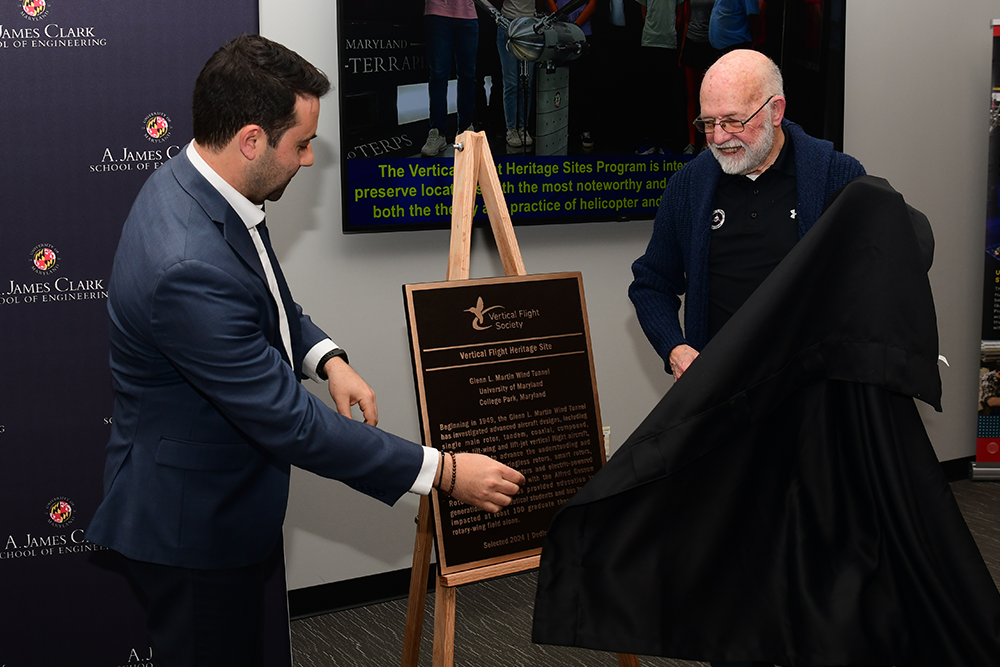
|
 |
Vertical Flight Society (VFS) Executive Director Angelo Collins presents a plaque designating the Glenn L. Martin Wind Tunnel as a Vertical Flight Heritage Site. The tunnel’s longtime director, Professor Emeritus Jewel Barlow, is pictured at right. Photo by Al Santos. |
|
During a ceremony held on April 16, the Vertical Flight Society (VFS) formally inducted the University of Maryland’s (UMD) Glenn L. Martin Wind Tunnel (GLMWT) as a Vertical Flight Heritage Site. The Vertical Flight Heritage Sites program recognizes and helps preserve locations where the most notable contributions have been made to the theory and practice of helicopter and other VTOL aircraft technologies.
Established in 1949 through a donation by aviation pioneer Glenn L. Martin, the founder of today’s Lockheed Martin, UMD’s wind tunnel has been in operation for more than 75 years.
The designation coincided with a personal milestone for its longtime director, Professor Emeritus Jewel Barlow, who has led operations at the facility for fifty years now, having begun his service at the facility in 1975.
“It’s been used to test practically everything that moves in the air or water,” Barlow said at the ceremony, which also featured remarks by UMD President Darryll J. Pines, A. James Clark School of Engineering Dean Samuel Graham, Jr., and Tom Beutner, visiting research professor at the GLMWT. Alfred Gessow Professor Anubhav Datta of the Alfred Gessow Rotorcraft Center (AGRC) was the host.
"The tunnel is what makes our aerospace engineering department and the AGRC unique in the nation," Datta said. "Testing and experimentation is central to the advancement of the arts and sciences of aeronautics and no facility can match the fidelity and realism of a wind-tunnel."
VFS Director of Strategy Mike Hirschberg and Vertical Flight Foundation Executive Director Angelo Collins also spoke at the event, as did Boeing Senior Technical Fellow Bobby Mathew, former Airbus Helicopters Vice President Tomasz Krysinski, and the U.S. Army’s Associate Chief for Science of Intelligent Systems, Rajneesh Singh.
Martin, the pioneering force behind the tunnel, had two purposes in mind when he built it. He wanted it to serve as a testing facility for his company, Martin Aircraft, and he also envisaged it as a space for UMD students to gain experience and instruction. In time, many more clients besides Martin’s firm have come to UMD to carry out tests: indeed, a veritable who’s who of the aerospace and rotorcraft industry has made use of the facility.
Today, testing and training remain the core of the GLMWT’s mission, said Krysinski, the former Airbus Helicopters VP, in his remarks.
Rotorcraft behavior can be hard to predict and therefore measurements are of critical importance, he noted, saying “it’s never exactly how it is in the book.” Students with experience at the GLMWT and AGRC have the extra level of expertise that comes with extensive hands-on work, Krysinski added.
UMD students associated with the AGRC have frequently won awards for research carried out at the tunnel. A recent example is Ph.D. student Xavier Delgado, who landed a Best Paper award in structural dynamics from the American Institute of Aeronautics and Astronautics for his study of high-speed whirl flutter.
The GLMWT was nominated for the designation by Lieutenant Colonel Paul Fardink, a former U.S. Army helicopter pilot and member of the VFS History Committee, who noted the role the facility has played in the AGRC’s success.
“I felt passionate about nominating the Glenn L. Martin Wind Tunnel because UMD has been a mainstay among the three Army-designated National Research Centers of Excellence for rotary wing technology and research for a long time,” he said. “And the wind tunnel has played a big part of that work.”
SEE ALSO:
Retrospective: The Glenn L. Martin Wind Tunnel Through the Years
April 29, 2025
|

